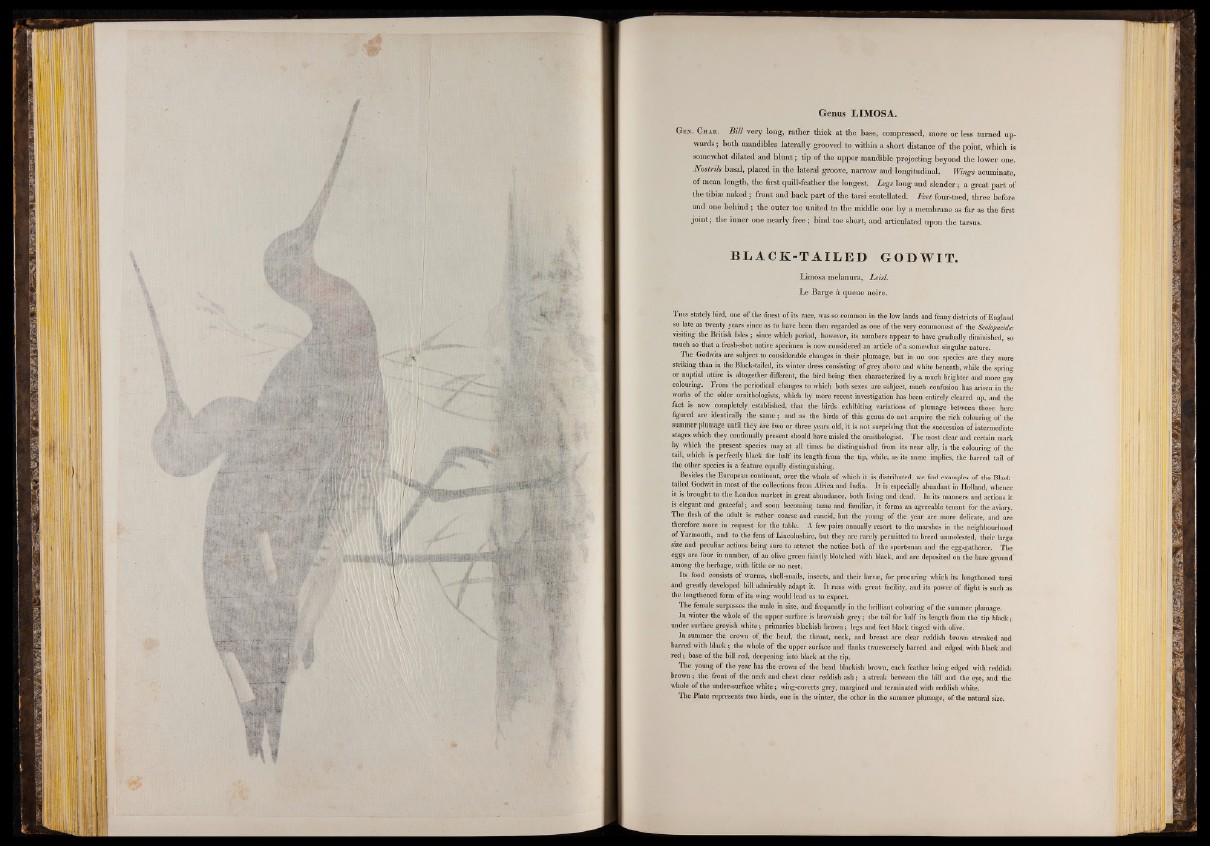
Genus LIMOSA.
Gen. Char. Bill very long, rather thick at the hase, compressed, more or less turned upwards;
both mandibles laterally grooved to within a short distance of the point, which is
somewhat dilated and blunt; tip of the upper maodible projecting beyond the lower one.
Nostrils basal, placed in the lateral groove, narrow and longitudinal. Wings acuminate,
of mean length, the first quill-feather the longest. L e g s long and slender; a great part of
the tibiae naked ; front and back part of the tarsi scutellated. F e e t four-toed, three before
and one behind ; the outer toe united to the middle one by a membrane as far as the first
joint; the inner one nearly free; hind toe short, and articulated upon the tarsus.
B L A C K - T A I L E D GODWIT.
Limosa melanura, L e is l.
Le Barge a queue noire.
T h i s stately bird, one o f the finest o f its race, was so common in the low lands and fenny districts o f England
so late as twenty years since as to have been then regarded as one o f the very commonest o f the Scolopacidce
visiting the British Isles ; since which period, however, its numbers appear to have gradually diminished, so
much so that a fresh-shot native specimen is now considered an article o f a somewhat singular nature.
The Godwits are subject to considerable changes in their plumage, but in no one species are they more
striking than in the Black-tailed, its winter dress consisting o f grey above and white beneath, while the spring
or nuptial attire is altogether different, the bird being then characterized by a much brighter and more gay
colouring. From the periodical changes to which both sexes are subject, much confusion has arisen in the
works o f the older ornithologists, which by more recent investigation has been entirely cleared up, and the
fact is now completely established, that the birds exhibiting variations o f plumage between those here
figured are identically the same; and as the birds o f this genus do not acquire the rich colouring o f the
summer plumage until they are two or three years old, it is not surprising that the succession o f intermediate
stages which they continually present should have misled the ornithologist. The most clear and certain mark
by which the present species may at all times be distinguished from its near ally, is the colouring o f the
tail, which is perfectly black for half its length from the tip, while, as its name implies, the barred tail of
the other species is a feature equally distinguishing.
Besides the European continent, over the whole o f which it is distributed, we find examples o f the Blacktailed
Godwit in most o f the collections from Africa and India. It is especially abundant in Holland, whence
it is brought to the London market in great abundance, both living and dead. In its manners and actions it
is elegant and graceful; and soon becoming tame and familiar, it forms an agreeable tenant for the aviary.
The flesh o f the adult is rather coarse and rancid, but the young o f the year are more delicate, and are
therefore more in request for the .table. A few pairs annually resort to the marshes in the neighbourhood
o f Yarmouth, and to the fens o f Lincolnshire, but they are rarely permitted to breed unmolested, their large
size and peculiar actions being sure to attract the notice both o f the sportsman and the egg-gatherer. The
eggs are four in number, o f an olive green faintly blotched with black, and are deposited on the bare ground
among the herbage, with little or no nest.
Its food consists o f worms, shell-snails, insects, and their lame, for procuring which its lengthened tarsi
and greatly developed bill admirably adapt it. It runs with great facility, and its power o f flight is such as
the lengthened form o f its wing would lead us to expect.
The female surpasses the male in size, and frequently in the brilliant colouring o f the summer plumage.
In winter the whole o f the upper surface is brownish g re y ; the tail for half its length from the tip black;
under surface greyish white; primaries blackish brown; legs and feet black tinged with olive.
In summer the crown o f the head, the throat, neck, and breast are clear reddish brown streaked and
barred with black; the whole o f the upper surface and flanks transversely barred and edged with black and
red ; base o f the bill red, deepening into black at the tip.
The young o f the year has the crown o f the head blackish brown, each feather being edged with reddish
brown ; the front o f the neck and chest clear reddish ash; a streak between the bill and the eye, and the
whole o f the under-surface white; wing-coverts grey, margined and terminated with reddish white.
The Plate represents two birds, one in the winter, the other in the summer plumage, o f the natural size.